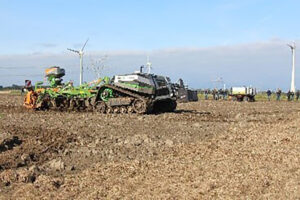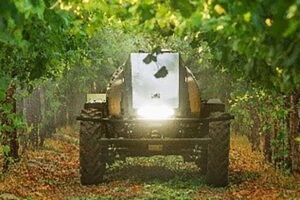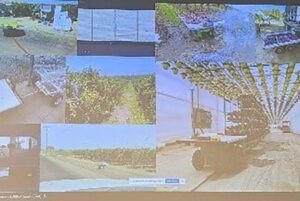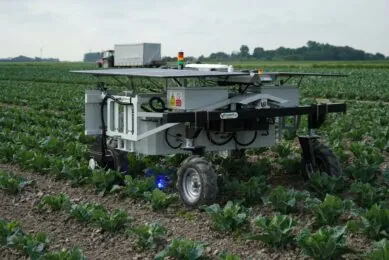VDI conference: are farmers ready for a booming field robot market?

Are farmers ready to welcome field robots on their farms? What do manufacturers and distributors do to speed up adoption and how does legislation help or hurdle?
These typical aspects and also questions were discussed during the third International VDI Conference on Automation and Robotics in Agriculture early July. Despite North American speakers from robot manufacturers/startups advanced.farm, Burro and GUSS Automation not being present in person, the conference proved to be a good platform for open and lively discussions between participants from among others Agco/Fendt, AgroIntelli, Arruga, CEMA, CNH, Farm-ING, Fraunhofer, geo-konzept, Jacto, John Deere, Kramp, Kuhn, K.U.L.T., Michelin and of course Future Farming. The occasion was also used to launch the world’s first independent testing initiative for field robots by Future Farming and the Wageningen University & ResearchFarm of the Future.
Control tower for robot operations
Dr. Sebastian Wagner from Fraunhofer IVI presented their helyOS open source framework control tower software for mobile machines that enables developers and users to develop, test and deploy autonomous mobile machine applications. The software is not only colour-blind but also open source, meaning that a great part of it is available for free and open for (limited) commercial use.
Wagner explained that the idea for helyOS arose some five years ago. “It’s a backend software framework for operating robots and robot fleets for solution providers and software developers. It’s like the control tower equivalent of open source Robot Operating Systems (ROS). helyOS is also used in the German Feldschwarm project.” helyOS operates as the bidirectional messenger between operations control and path planning software for one or multiple autonomous vehicles and the vehicles themselves.
30% of farmers consider buying robots
Wagner demonstrated the use of helyOS with a video of an autonomous e-truck for enclosed (fenced) parts of logistics centres. That brought the attention to Johannes Lehmann from the German institute for standardisation (DIN) explaining that Germany currently is the only European country with a law on autonomous driving (level 3 autonomy) on public roads. “In contradiction to the USA where 44 states allow testing of autonomous trucks (level 4 autonomy) and 26 states currently allow commercial deployment of autonomous trucks”, he says.

Lehmann also explained that a German study amongst 500 farmers showed that 3% of them are currently using field robots and that 30% of them are actively considering the use of field robots. Thomas Muhr, Managing Director of geo-konzept and distributor of the AgroIntelli Robotti and AgXeed robot tractors: “We have sold 3 robots so far and have ordered another 3. I see a market potential for 15 units in 2023 and 25 units in 2024.” Muhr also said to believe that data will become a (separate) business model. Thomas Beach, founder of UK Autonomous Agri Solutions said to foresee selling 5 robots annually. “We have currently sold 2 Robotti’s and 1 FarmDroid FD20 field robot.”
“Legislation however is not in line with the technical developments and that is also one of the barriers for adoption of field robots by farmers. Other barriers include lack of technical development, acceptance and economies of scale”, said Lehmann. Ivo Hostens, Technical Director of CEMA went into the ongoing (lobbying) work of CEMA to make the current ISO 18497 machinery directive suitable for automated driving and functions. Ánd, to develop new so-called C standards related to operations such as autonomous tillage, weeding and spraying. “It’ll probably take two more years to develop a set of basic rules and then two or three additional years for the final standard”, Hostens said.
Managing expectations (better)
Gregor Witzmann of Austrian startup Farm-ING Smart Farm Equipment explained by means of a use case why it is important for manufacturers and distributors of robots and autonomous vehicles to manage farmers’ expectations before digging into robots. “At a large 1,600 ha Austrian vegetable farm, we wanted to grow 100 ha of sugar maize autonomously using an AgroIntelli Robotti. We ended up doing 60 ha instead of 100 mainly because we did not manage to do all the preparations in time. It’s especially the path and operations planning that requires sufficient time during each winter. We clearly underestimated this. Another limitation proved to be the hoeing capacity of the 4-row hoe, that was too limited. We also learned that robots need to have means to monitor the performance (and failures) of the operation as farmers don’t trust robots (yet). They fear that it’ll hoe the crop instead of the weeds.”
From contracting to automation

Gary Thompson of GUSS Automation explained how GUSS autonomous sprayers was ‘born’ from the family contract spraying business that started in 1982 ending up spraying up to 5,000 acres (over 2,000 ha) per day. “The idea for GUSS not only arose because of the large acreage, but also because of labour shortage and costs and regulation. One person can now operate and monitor up to 8 GUSS sprayers. We did not intend to sell the machine but after the debut at the World Ag Expo in 2018, we got a tremendous amount of interest to purchase. The first machine was then delivered to a customer in 2019.”
GUSS currently produces 1.5 units per week and has 155 units operational (GUSS and Mini GUSS). That means that 33 units have been added in the first half of 2022 according to the statistics in the Future Farming field robots’ catalogue. In 2021, 54 units were added. 13 out of the 155 units are operated by the family’s contracting business. GUSS currently costs around $ 300.000. “We didn’t expect to sell GUSS sprayers to smaller farms operating like two conventional pulled sprayers but we now see that they can replace those two sprayers (and their operators) by one GUSS sprayer and one operator.”

Charlie Andersen from Burro explained how customers can have manufacturers shine a different light on the intended use of their robots. “We see that our collaborative autonomous vehicle is used for a lot more purposes than initially intended and that it comes across the most unexpected situations. We saw kids having Burro pull a trailer with a dummy cow on it for practising their cowboy skills, Burro running into a camp fire in the orchard lit by workers to cook their lunch, Burro hitting pallets with stuff, running into trailers that were not supposed to park there, et cetera. On the other hand, we went from 10 faults per mile initially in 2018 to 8 to 20 miles per fault today (on a total of 28,500 autonomous miles at 20+ growers) and expect to go to 20+ miles per fault in 2023. Then it becomes a scalable operation where we ‘ship a product without shipping a person’.”
Burro currently has around 200 units in operation compared to 100 units at the end of 2021. Burro is available for $ 20,000 including a 2-year software license. Ongoing software updates and support is $ 2,199 per Burro per year. “Our goal is to build Burro as a people-scale autonomous mobility platform for work outdoors to support across many industries”, concluded Andersen.
Join 17,000+ subscribers
Subscribe to our newsletter to stay updated about all the need-to-know content in the agricultural sector, two times a week.



